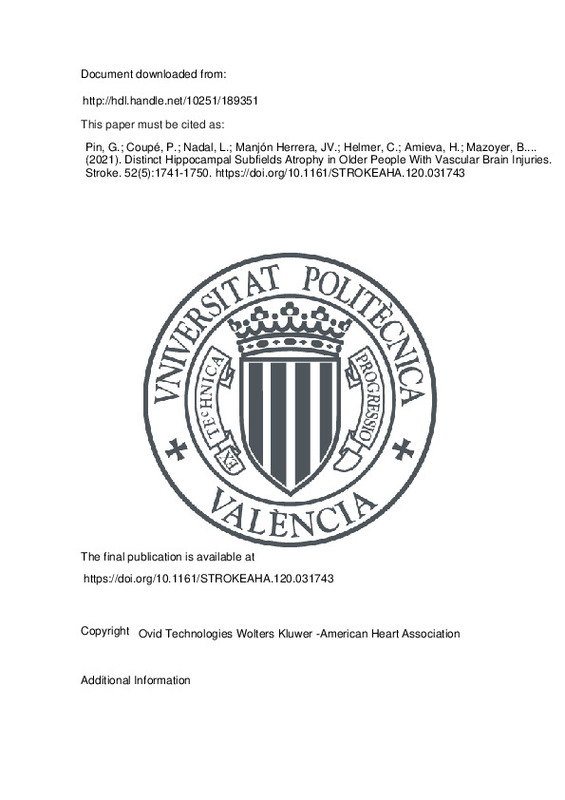JavaScript is disabled for your browser. Some features of this site may not work without it.
Buscar en RiuNet
Listar
Mi cuenta
Estadísticas
Ayuda RiuNet
Admin. UPV
Distinct Hippocampal Subfields Atrophy in Older People With Vascular Brain Injuries
Mostrar el registro sencillo del ítem
Ficheros en el ítem
| dc.contributor.author | Pin, Grégoire
|
es_ES |
| dc.contributor.author | Coupé, Pierrick
|
es_ES |
| dc.contributor.author | Nadal, Louis
|
es_ES |
| dc.contributor.author | Manjón Herrera, José Vicente
|
es_ES |
| dc.contributor.author | Helmer, Catherine
|
es_ES |
| dc.contributor.author | Amieva, Helene
|
es_ES |
| dc.contributor.author | Mazoyer, Bernard
|
es_ES |
| dc.contributor.author | Dartigues, Jean-François
|
es_ES |
| dc.contributor.author | Catheline, Gwenaelle
|
es_ES |
| dc.contributor.author | Planche, Vincent
|
es_ES |
| dc.date.accessioned | 2022-11-07T16:34:29Z | |
| dc.date.available | 2022-11-07T16:34:29Z | |
| dc.date.issued | 2021-05 | es_ES |
| dc.identifier.issn | 0039-2499 | es_ES |
| dc.identifier.uri | http://hdl.handle.net/10251/189351 | |
| dc.description.abstract | [EN] Background and Purpose: Many neurological or psychiatric diseases affect the hippocampus during aging. The study of hippocampal regional vulnerability may provide important insights into the pathophysiological mechanisms underlying these processes; however, little is known about the specific impact of vascular brain damage on hippocampal subfields atrophy. Methods: To analyze the effect of vascular injuries independently of other pathological conditions, we studied a population-based cohort of nondemented older adults, after the exclusion of people who were diagnosed with neurodegenerative diseases during the 14-year clinical follow-up period. Using an automated segmentation pipeline, 1.5T-magnetic resonance imaging at inclusion and 4 years later were assessed to measure both white matter hyperintensities and hippocampal subfields volume. Annualized rates of white matter hyperintensity progression and annualized rates of hippocampal subfields atrophy were then estimated in each participant. Results: We included 249 participants in our analyses (58% women, mean age 71.8, median Mini-Mental State Evaluation 29). The volume of the subiculum at baseline was the only hippocampal subfield volume associated with total, deep/subcortical, and periventricular white matter hyperintensity volumes, independently of demographic variables and vascular risk factors (ß=¿0.17, P=0.011; ß=¿0.25, P=0.020 and ß=¿0.14, P=0.029, respectively). In longitudinal measures, the annualized rate of subiculum atrophy was significantly higher in people with the highest rate of deep/subcortical white matter hyperintensity progression, independently of confounding factors (ß=¿0.32, P=0.014). Conclusions: These cross-sectional and longitudinal findings highlight the links between vascular brain injuries and a differential vulnerability of the subiculum within the hippocampal loop, unbiased of the effect of neurodegenerative diseases, and particularly when vascular injuries affect deep/subcortical structures. | es_ES |
| dc.description.sponsorship | The 3C Study is conducted under a partnership agreement among the Institut National de la Sante et de la Recherche Medicale (INSERM), Bordeaux University, and Sanofi. The Fondation pour la Recherche Medicale funded the preparation and initiation of the study. The 3C Study is also supported by Caisse Nationale Maladie des Travailleurs Salaries, Direction Generale de la Sante, Mutuelle Generale de l'Education Nationale, Institut de la Longevite, Conseils Regionaux d'Aquitaine et Bourgogne, Fondation de France, and the Ministry of Research-INSERM Programme "Cohortes et collections de donnees biologiques". The followups have also been funded by ANR 2007LVIE 003, the "Fondation Plan Alzheimer" and the Caisse Nationale de Solidarite pour l'Autonomie (CNSA). This work benefited from the support of the project DeepvolBrain of the French National Research Agency (ANR-18-CE45-0013) and by the Spanish DPI2017-87743-R grant from the Ministerio de Economia, Industria y Competitividad of Spain. In addition, this study was achieved within the context of the Laboratory of Excellence TRAIL ANR-10-LABX-57 for the BigDataBrain project. Finally, we thank the Investments for the future Program IdEx Bordeaux (ANR-10-IDEX-03-02, HL-MRI Project), Cluster of excellence CPU and the CNRS. VP also received grants from Fondation Bettencourt Schueller (CCA-Inserm-Bettencourt) during the conduct of the study but unrelated to the present work. The sponsors did not participate in any aspect of the design or performance of the study, including data collection, management, analysis, and the interpretation or preparation, review, and approval of the manuscript. | es_ES |
| dc.language | Inglés | es_ES |
| dc.publisher | Ovid Technologies Wolters Kluwer -American Heart Association | es_ES |
| dc.relation.ispartof | Stroke | es_ES |
| dc.rights | Reserva de todos los derechos | es_ES |
| dc.subject | Aging | es_ES |
| dc.subject | Atrophy | es_ES |
| dc.subject | Demography | es_ES |
| dc.subject | Hippocampus | es_ES |
| dc.subject | Risk factors | es_ES |
| dc.title | Distinct Hippocampal Subfields Atrophy in Older People With Vascular Brain Injuries | es_ES |
| dc.type | Artículo | es_ES |
| dc.identifier.doi | 10.1161/STROKEAHA.120.031743 | es_ES |
| dc.relation.projectID | info:eu-repo/grantAgreement/AEI/Plan Estatal de Investigación Científica y Técnica y de Innovación 2013-2016/DPI2017-87743-R/ES/DESARROLLO DE UNA PLATAFORMA ONLINE PARA EL ANALISIS ANATOMICO DEL CEREBRO TOLERANTE A LA PRESENCIA DE ALTERACIONES PATOLOGICAS/ | es_ES |
| dc.relation.projectID | info:eu-repo/grantAgreement/ANR//ANR-10-IDEX-03-02/ | es_ES |
| dc.relation.projectID | info:eu-repo/grantAgreement/ANR//ANR-18-CE45-0013/ | es_ES |
| dc.relation.projectID | info:eu-repo/grantAgreement/ANR//ANR 2007LVIE 003/ | es_ES |
| dc.relation.projectID | info:eu-repo/grantAgreement/ANR//ANR-10-LABX-57/ | es_ES |
| dc.rights.accessRights | Abierto | es_ES |
| dc.description.bibliographicCitation | Pin, G.; Coupé, P.; Nadal, L.; Manjón Herrera, JV.; Helmer, C.; Amieva, H.; Mazoyer, B.... (2021). Distinct Hippocampal Subfields Atrophy in Older People With Vascular Brain Injuries. Stroke. 52(5):1741-1750. https://doi.org/10.1161/STROKEAHA.120.031743 | es_ES |
| dc.description.accrualMethod | S | es_ES |
| dc.relation.publisherversion | https://doi.org/10.1161/STROKEAHA.120.031743 | es_ES |
| dc.description.upvformatpinicio | 1741 | es_ES |
| dc.description.upvformatpfin | 1750 | es_ES |
| dc.type.version | info:eu-repo/semantics/publishedVersion | es_ES |
| dc.description.volume | 52 | es_ES |
| dc.description.issue | 5 | es_ES |
| dc.identifier.pmid | 33657856 | es_ES |
| dc.relation.pasarela | S\462326 | es_ES |
| dc.contributor.funder | Université de Bordeaux | es_ES |
| dc.contributor.funder | Agencia Estatal de Investigación | es_ES |
| dc.contributor.funder | Agence Nationale de la Recherche, Francia | es_ES |
| dc.contributor.funder | Institut National de la Santé et de la Recherche Médicale | es_ES |







![[Cerrado]](/themes/UPV/images/candado.png)

